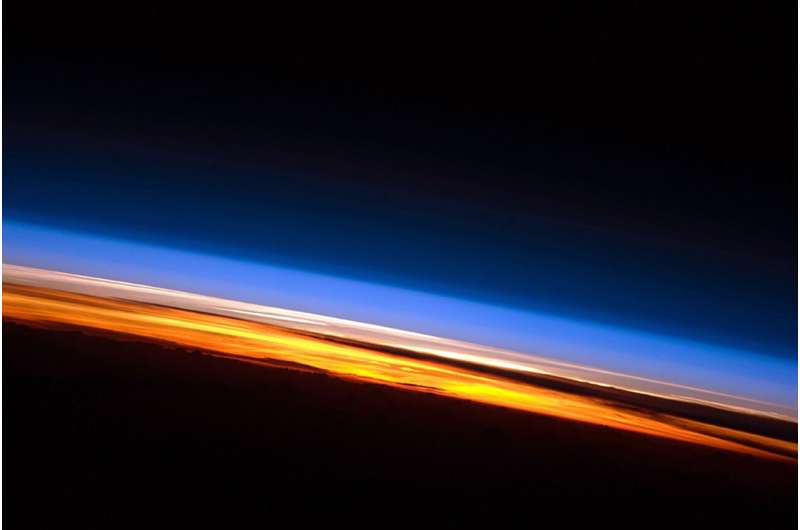
November 18, 2024 by Matthew Carroll, Pennsylvania State University
Collected at: https://phys.org/news/2024-11-statistical-approach-atmosphere-early-earth.html
As energy from the sun reaches Earth, some solar radiation is absorbed by the atmosphere, leading to chemical reactions like the formation of ozone and the breakup of gas molecules. A new approach for modeling these reactions, developed by a team led by scientists at Penn State, may improve our understanding of the atmosphere on early Earth and help in the search for habitable conditions on planets beyond our solar system.
The researchers have reported in the journal JGR Atmospheres that using a statistical method called correlated-k can improve existing photochemical models used to understand conditions on early Earth.
The approach can help scientists better understand the atmospheric composition of early Earth and will play an important role as new observatories come online in the coming decades that can provide new data on exoplanet atmospheres, the scientists said.
“One way we search for potential life in space is to look for biosignatures,” said Jim Kasting, Evan Pugh University Professor Emeritus of Geosciences at Penn State and co-author of the study. “For detecting that we need some kind of telescope to give us spectra of the atmosphere. And then a photochemical model like ours can help calculate the chemical condition in the atmosphere and potentially find biosignatures. And that calculation is very important for searching for life in space.”
Many models used for running atmospheric calculations of early Earth and Earth-like exoplanets are based on a one-dimensional (1D) photochemical model developed at Penn State, explained Aoshuang Ji, who received a doctoral degree in geosciences from Penn State and conducted this research at the university. This 1D photochemical model simulates atmospheric chemistry along a single vertical column.
“We think it’s important that we made this improvement to our photochemical model, so that this can help improve other studies and future research about the atmosphere of early Earth as well as Earth-like exoplanets,” Ji said.
Ultraviolet radiation from the sun plays an important role in forming ozone in our atmosphere, the researchers said. As oxygen molecules—made up of two oxygen atoms—absorb radiation, they can break down into free oxygen atoms. Those atoms can then join other oxygen molecules (O2) to form ozone (O3). This process also shields other gases in the atmosphere from absorbing the radiation and breaking down.
But the absorption is difficult to model due to its complex structure at specific wavelengths called the Schumann-Runge (SR) bands.
“Good models for SR absorption in today’s atmosphere already exist, but not all of them may be suitable for use in low-O2 atmospheres like early Earth,” said Ji, who is now a NASA Postdoctoral Fellow at the University of California, Riverside.
The current version of the Whole Atmosphere Community Climate Model at the National Center for Atmospheric Research, for example, does a good job modeling ultraviolet radiation absorption for Earth’s present atmosphere, the researchers said. But it neglects scattering—or how particles in the atmosphere deflect or redirect incoming solar radiation—which becomes important at low levels of atmospheric oxygen.
The Penn State 1D model, developed by Kasting, includes scattering but is based on an out-of-date band model, and it neglects the temperature dependence on the chemical reactions at low oxygen levels, the scientists said.
The team turned to the correlated-k approach, which has been widely used in other climate models for accurately grouping different wavelengths of the sun’s energy. Using the correlated-k approach with their 1D photochemical model improved its accuracy for all oxygen levels and temperature profiles, the scientists said.
“It helps simplify the problem by grouping wavelengths into bands and assuming that within each band, the absorption properties of the atmosphere are correlated in a predictable way,” Ji said. “It provides a balance—it is less computationally intensive than some other methods while still providing a good approximation of how radiation is being absorbed and scattered.”
Also contributing to this work were: Kenneth Minschwaner, a professor at New Mexico Institute of Mining and Technology; Gustavo Palancar, an assistant researcher at the National University of Cordoba in Argentina; Rafael P. Fernández, a professor, and Orlando Tomazzeli, a doctoral candidate at the Institute for Interdisciplinary Science of National Research Council in Argentina; Guillaume Chaverot, a researcher at University of Geneva in Switzerland; and Mackenzie Barker, an undergraduate in the College of Earth and Mineral Sciences.
More information: Aoshuang Ji et al, A Correlated‐K Parameterization for O2 Photolysis in the Schumann‐Runge Bands, Journal of Geophysical Research: Atmospheres (2024). DOI: 10.1029/2023JD040610
Journal information: Journal of Geophysical Research – Atmospheres

Leave a Reply